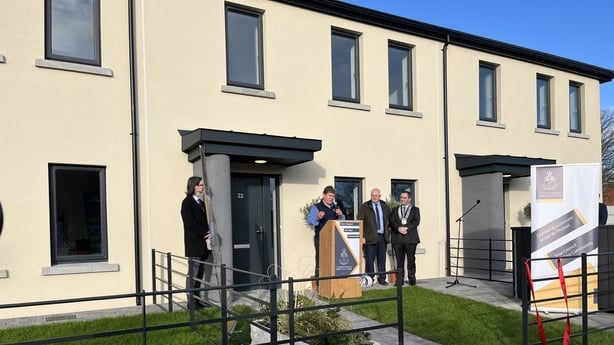A woman who was waiting for a house for ten years has said becoming one of the first people to move into a 3D printed house in Ireland and the UK is like "winning the lottery".
What might have been a dream for Shannon Norton and her ten-year-old son, TJ, this time last year has become a reality.
Ms Norton and two other local families, who were previously on the Louth County Council social housing list, have officially collected the keys to their new homes in Grange Close in Dundalk.
The construction of the houses involved the installation of a 3D concrete printer on a gantry, which was programmed to pipe out concrete as per a digital plan.
The cavity walls were built from scratch, without using concrete blocks.
Ms Norton has said while she is still trying to get her head around the technology that was used to build her new home, she is delighted to be moving in.
"It's just amazing, overwhelming. I can’t believe it. I’m still in shock still.
"[I’ve been waiting for] 10 years. It’s massive. I’m currently renting a house that’s full of mould so to get here is like winning the lottery.
"I was constantly checking for updates, trying to get a wee peek inside it, but I just had to wait until this morning. I couldn’t understand how it was built like that. It looked so easy, but obviously, it took a lot of work as well, but not too long, thank God."
The three two-storey, three-bedroom terraced houses were built over the course of six months between last May and November.

Developers have said that the COBOD 3D construction printing technology used in the project automates the concrete laying process, resulting in time and cost savings, improved structural integrity, and the more efficient use of resources.
The housing development at Grange Close in Dundalk was the result of a partnership between Louth County Council and Irish construction technology company Harcourt Technologies (HTL), as well as construction firm Roadstone, the Louth & Meath Education & Training Board (LMETB) and Harcourt Architects.
Each of the three houses has a gross internal area of 110 square metres and an A2 energy rating.
The printed structures were achieved in 12 print days, with a total machine on-site time of 18 working days.
HTL has said that this is 60% faster than the traditional 44-day concrete block method and the total working days for the project amounted to 132, achieving a 35% savings compared to the 203 days required for traditional construction.
In monetary terms, the company said the construction cost of each home was around €253,000 excluding VAT and this equates to existing traditional construction costs.







